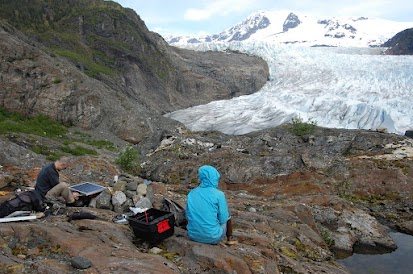Mendenhall Glacier, Up Close and Personal
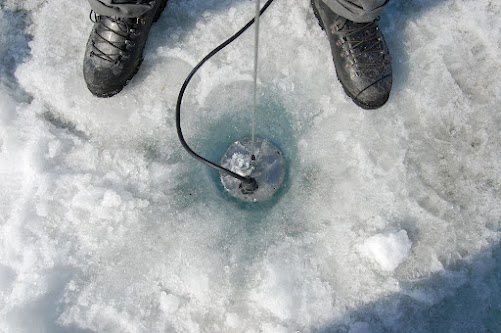
IRIS/PASSCAL has been a key supporter of a novel deployment of equipment at Mendenhall Glacier in Alaska. A team of researchers from the University of Alaska Southeast, the University of California Santa Cruz, and the Alaska Science Center in Anchorage have been performing an ambitious analysis as part of a low-budget cutting-edge project. Above, a Trillium Compact AT is lowered directly into a borehole in the glacier.
Project participant Jake Walter (a graduate student at the University of California Santa Cruz) describes the project:
One approach to investigating the seasonal evolution of subglacial drainage systems is to monitor the seismicity with passive seismic stations installed directly on the ice. Traditional land-based stations suffer from highly attenuated seismic signals, due to being located some distance away from the ice.
Installing conventional seismic instruments in-situ, on the ice, is difficult or impossible at temperate glaciers where glacier melt rates approach 6-8 m/yr. While ice borehole seismology is not a new concept, Mendenhall Glacier provides a unique setting to test out different installation approaches and different instruments, as it is easily accessed from the state capital Juneau, AK.
Beginning in May 2012, we have drilled boreholes and installed different instruments (short period L22B and broadband Trillium Compact AT) in the water-filled boreholes, allowing them to freeze into the borehole, as well as testing the alternative technique of packing those boreholes with sand. Data analysis later this fall should point towards "preferred" methods/instrumentation for future experiments of this type.
Photographs of some of the participants in this unique effort appear below. Not pictured: Shad O'Neel of the Alaska Science Center.
|
Assistant Professor Jason Amundson and undergraduate Jamie Bradshaw of University of Alaska Southeast finish installing a Guralp 6TD on bedrock exposed by the retreat of Mendenhall Glacier. |
|
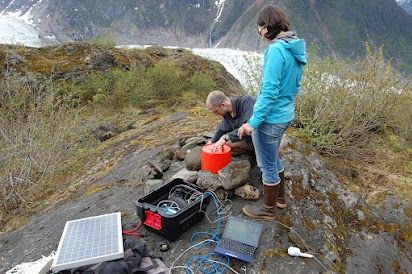 |
Amundson and Bradshaw, installing another station at the glacier. |
|
Jamie Bradshaw uses the steam drill to place an anchor at 8 m depth, which will secure the datalogger box, with an attached solar panel. The Trillium Compact AT is installed in an adjacent 6 inch diameter hole that is 4 m deep. A steel cable secures the instrument to the datalogger box. |
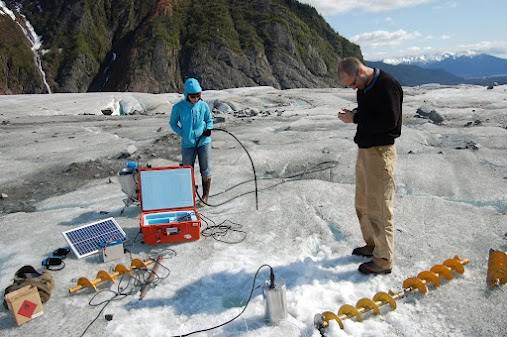 |
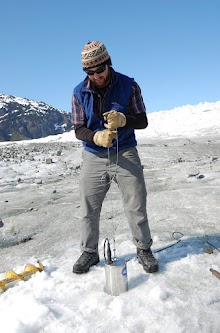 |
Here, University of California Santa Cruz graduate student Jake Walter lowers a Trillium Compact AT directly into the borehole. |
Jake Walter adds this comment:
The testing of these approaches is further motivated by a glacial lake outburst flood that occurred in 2011 and one that we recorded this summer (2012) when the instruments were operating. The data from this experiment may provide insight to the dynamics of fluid routing beneath the glacier.
It is hoped that this type of deployment will lead to better knowledge of glacier dynamics. Stay tuned for results as they emerge!
- Home
- General Information
- Instrumentation
- Dataloggers
- Sensors
- All-In-One Systems
- Power Systems
- Field Procedures
- Controlled Sources
- Seismic Source Facility
- Magnetotelluric Systems at PASSCAL
- Ground Penetrating Radar
- Power and Memory Calculations Form
- Data Archiving
- Apply for a PI Account
- Experiment Scheduling
- Polar
- Important Hardware/Software Notes
- USArray
- Software

